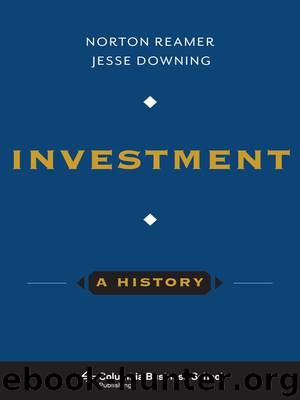Investment by Norton Reamer

Author:Norton Reamer
Language: eng
Format: epub
Tags: BUS023000, Business & Economics/Economic History, BUS077000, Business & Economics/Corporate & Business History
Publisher: Columbia University Press
Published: 2016-02-15T16:00:00+00:00
The Buildup
Thus the stage was set for various asset bubbles, which may have been further promoted by the relatively easy monetary environment supported by the Federal Reserve led by Alan Greenspan. These bubbles, which included the dot-com bubble of 1999–2000 and a much more consequential housing bubble in 2004–2006, seemed to grow largely unfettered. In hindsight, the dot-com bubble, which had substantial stock market impact, appears to have had much less systemic economic impact than the housing bubble that followed it.
A characteristic of the economy we do not yet seem to be able to address is the destabilizing element of economic expansion on participant overconfidence and speculation. The late economist Hyman P. Minsky addressed this tendency in various publications, including his 1986 book Stabilizing an Unstable Economy.34 Minsky recognized an all-too-human characteristic of expanding economies that was present in the housing bubble of 2004–2006: excessive confidence, excessive greed, excessive speculation, and excessive carelessness developed in market participants. For all the actions, new regulations, bailouts, and other remedial efforts the administration and Federal Reserve lavished on the financial crisis of 2007–2009, it is far from clear that any material progress has been made in addressing these all-too-human tendencies of the economic cycle.
In addition, human psychology, policy errors, and regulatory mistakes were dramatically compounded by the advent of a hyperleveraged US economy. In this context it is critical to remember that the aggressive use of derivatives in market operations not associated with hedging constituted a dramatic element of leverage in the banking system.
The immediate precursor to the financial crisis was the run-up in housing prices in the United States with similar manifestations in other countries, one notable example being Spain. But the devastation that was sowed depended heavily on complex financial instruments that were created, sold to the public, and invested in by various individuals, companies, and institutions. All this was compounded by abundant use of leverage, including derivatives, which were laced throughout the United States and ultimately the international economic system.35
Housing, an asset that has over time appreciated at about the rate of inflation, suddenly became a growth dynamo with “cannot-fail” characteristics in the early years of the twenty-first century (from 2002 to 2006). Between 1947 and the mid-1990s, US house prices as measured by the Case-Shiller index remained relatively flat, with the index ticking up a negligible amount (86.6 in 1947 to 87 in 1996). However, between 1996 and 2006, the index soared from 87.0 to 160.6 and then dropped by fifty-five points to 105.7 by 2009.36
Valuing assets is often difficult, and valuing residential real estate is no different. However, in comparison to the average income levels available to support the investments homeowners were making and to typical rents that might have been paid as an alternative, housing had not just appreciated too rapidly but had also become too expensive for many of the market participants who were making the investment.
To sustain some of this feverish activity, market makers propagated the myth that there was no history of any appreciable national price decline in housing.
Download
This site does not store any files on its server. We only index and link to content provided by other sites. Please contact the content providers to delete copyright contents if any and email us, we'll remove relevant links or contents immediately.
International Integration of the Brazilian Economy by Elias C. Grivoyannis(90771)
The Radium Girls by Kate Moore(11921)
Turbulence by E. J. Noyes(7935)
Nudge - Improving Decisions about Health, Wealth, and Happiness by Thaler Sunstein(7615)
The Black Swan by Nassim Nicholas Taleb(7010)
Rich Dad Poor Dad by Robert T. Kiyosaki(6399)
Pioneering Portfolio Management by David F. Swensen(6226)
Man-made Catastrophes and Risk Information Concealment by Dmitry Chernov & Didier Sornette(5921)
Zero to One by Peter Thiel(5684)
Secrecy World by Jake Bernstein(4643)
Millionaire: The Philanderer, Gambler, and Duelist Who Invented Modern Finance by Janet Gleeson(4374)
The Age of Surveillance Capitalism by Shoshana Zuboff(4209)
Skin in the Game by Nassim Nicholas Taleb(4161)
Bullshit Jobs by David Graeber(4094)
The Money Culture by Michael Lewis(4075)
Skin in the Game: Hidden Asymmetries in Daily Life by Nassim Nicholas Taleb(3929)
The Dhandho Investor by Mohnish Pabrai(3698)
The Wisdom of Finance by Mihir Desai(3650)
Blockchain Basics by Daniel Drescher(3500)
